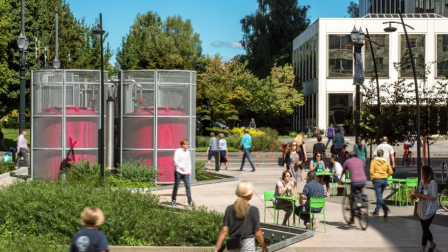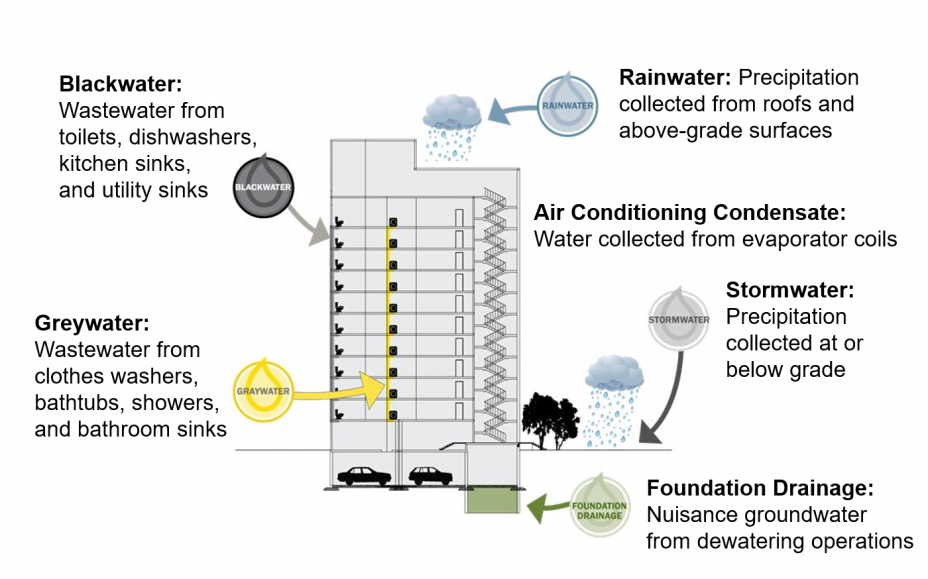Onsite Non-Potable Water Reuse Research
On this Page
Increasing pressures on water resources have led to greater water scarcity and a growing demand for alternative water sources. Onsite non-potable water reuse is one solution that can help communities reclaim, recycle, and then reuse water for non-drinking water purposes. Onsite non-potable water reuse systems (ONWS) capture and treat water sources generated from within or surrounding a building, such as wastewater, greywater, stormwater, or roof collected rainwater. The treated water is then reused onsite or locally for non-drinking purposes, such as toilet flushing, clothes washing, and ornamental plant irrigation.
EPA is collaborating with states and utilities who are facilitating the development of ONWS to define treatment and monitoring approaches that will ensure safe adoption and to build the utility business case for implementing such systems.
Within a building, several water sources are generated that can be treated and used onsite or in a local area for non-drinking water purposes, such as toilet flushing, clothes washing, and ornamental plant irrigation.
Risk-Based Modeling
EPA researchers are conducting risk-based modeling to understand the human health risks associated with onsite reuse of locally-collected waters, such as wastewater, greywater, stormwater, and roof-collected rainwater, for non-potable applications in and around buildings. Quantitative Microbial Risks Assessment (QMRA) models were developed to characterize potential risks associated with these systems and to define the levels of pathogen removal needed to perform reuse safely. These reduction targets, reported for each of the three major groups of waterborne pathogens (viruses, bacteria, and protozoans) across various combinations of water sources and end uses, provide specific performance metrics for treatment systems.
Increasing pressures on water resources have led to greater water scarcity and a growing demand for alternative water sources. Onsite non-potable water reuse is one solution that can help communities reclaim, recycle, and then reuse water for non-drinking water purposes. Onsite non-potable water reuse systems (ONWS) capture and treat water sources generated from within or surrounding a building, such as wastewater, greywater, stormwater, or roof collected rainwater. The treated water is then reused onsite or locally for non-drinking purposes, such as toilet flushing, clothes washing, and ornamental plant irrigation.
This research also includes the evaluation of initial pathogens concentrations in different onsite water sources as well as modeling the risks associated with proposed treatment options and ONWS cross-connections.
Recent Research Publications:
- Human Health Impact of Cross-connections in Non-potable Reuse SystemsExit(2018). QMRA was used to estimate the microbial risks from two contamination pathways in ONWS: (1) contamination of potable water by (treated) reclaimed, non-potable water, and (2) contamination of reclaimed, non-potable water by wastewater or greywater.
- Human Health Impact of Non-potable Reuse of Distributed Wastewater and Greywater Treated by Membrane Bioreactors (2018). The annual probability of infection resulting from non-potable exposures to distributed greywater and domestic wastewater treated by an aerobic membrane bioreactor (MBR) followed by chlorination was assessed. A probabilistic QMRA was conducted for both residential and office buildings and a residential district using Norovirus, Rotavirus, Campylobacter jejuni, and Cryptosporidium spp. as reference pathogens.
- Risk-based Enteric Pathogen Reduction Targets for Non-potable and Direct Potable Use of Roof Runoff, Stormwater, and Greywater (2017). This journal article presents risk-based enteric pathogen log reduction targets for non-potable and potable uses of a variety of alternative source waters (i.e., locally-collected greywater, roof runoff, and stormwater). Reference pathogens were in the genera Rotavirus, Mastadenovirus (human adenoviruses), Norovirus, Campylobacter, Salmonella, Giardia, and Cryptosporidium.
- Simulation of Enteric Pathogen Concentrations in Locally-collected Greywater and Wastewater for Microbial Risk Assessments (2017). This journal article presents an approach to modeling pathogen concentrations in variously-sized greywater and combined wastewater collection systems based on epidemiological pathogen incidence rates, user population size, and fecal loadings to various residential wastewater sources. Pathogen infections were modeled within various population sizes for seven reference pathogens: three viruses (adenoviruses, Norovirus, and Rotavirus); two bacteria (Campylobacter and Salmonella spp.); and two protozoa (Cryptosporidium and Giardia spp.).
- Review of Pathogen Treatment Reductions for Onsite Non-potable Reuse of Alternative Source Waters (2017). This journal article presents a review of the relevant QMRA literature to prioritize knowledge gaps and identify health-protective pathogen treatment reduction targets.
Monitoring of Treatment Performance
Monitoring the treatment processes in ONWS is necessary to ensure that recycled water is treated appropriately to reduce pathogens for safe application. Since pathogen monitoring is inefficient, other non-pathogenic microorganisms are being investigated to stand in for pathogens. This research involves describing and quantifying the microorganisms, both bacterial and viral, found in these locally-collected wastewaters. In addition, the alternative microorganisms are evaluated to ensure they are removed in a similar way as pathogens are during ONWS treatment. The use of alternative microorganisms will facilitate monitoring of ONWS to verify that treatment systems are performing as intended.
Recent Research Publications:
- Reducing Inherent Biases Introduced during DNA Viral Metagenome Analyses of Municipal Wastewater (2018). This study was conducted to understand the inherent variability introduced when conducting viral metagenomic analyses of wastewater and provide a bioinformatic strategy to accurately analyze sequences for viral community analyses.
- Characterization of the Relative Importance of Human-and-Infrastructure-Associated Bacteria in Greywater: A Case Study (2015). This journal article characterizes the bacterial composition from (1) various points throughout a greywater recycling system that collects shower and sink handwash water into an equalization tank prior to treatment, and (2) laundry water effluent of a commercial‐scale washer.
- Human Mitochondrial DNA and Endogenous Bacteria Surrogates for Risk Assessment of Greywater Reuse (2014). In this study, high throughput bacterial sequencing and quantitative polymerase chain reaction (qPCR) was used to analyze potential microbial surrogates in wastewater sourced from an industrial laundry. In addition, human mitochondrial DNA was explored as a new, potentially more reliable molecular marker.
Life Cycle Assessment
While local entities have identified a number of drivers for implementing ONWS, ranging from addressing water scarcity to the development of green space within urban areas, quantifiable data is needed on the life cycle impacts and costs to build the business case for implementation. From the perspective of the local utility or government, the implementation of ONWS must account for the costs of installing and operating the ONWS to the benefits derived (e.g., avoided drinking water costs). To provide insight into this system level perspectives, life cycle costs and impacts were assessed for ONWS of various scales and types.
Recent Research Publications:
- Energy and greenhouse gas life cycle assessment and cost analyst of aerobic and anaerobic membrane bioreactor systems: Influence of scale, population density, climate, and methane recovery (2018). This study calculated the energy and greenhouse gas life cycle and cost profiles of transitional aerobic and anaerobic membrane bioreactors. Membrane bioreactors represent a promising technology for decentralized wastewater treatment and can produce recycled water to displace potable water.
Collaboration
 Hassalo on 8th Wastewater Treatment & Reuse System in Portland, Oregon—an example of an onsite non-potable water resue system.EPA researchers are committed to active engagement with various partners and stakeholders to ensure that implemented water reuse protect public health. One of these partners, the National Blue Ribbon Commission for Onsite Non-Potable Water Systems (NBRC), is an nationwide group of utilities and state/local public health agencies that are interested in advancing the safe adoption of ONWS. To that end, NBRC has produced several industry guidance documents that incorporate the results of EPA research in this area.
Hassalo on 8th Wastewater Treatment & Reuse System in Portland, Oregon—an example of an onsite non-potable water resue system.EPA researchers are committed to active engagement with various partners and stakeholders to ensure that implemented water reuse protect public health. One of these partners, the National Blue Ribbon Commission for Onsite Non-Potable Water Systems (NBRC), is an nationwide group of utilities and state/local public health agencies that are interested in advancing the safe adoption of ONWS. To that end, NBRC has produced several industry guidance documents that incorporate the results of EPA research in this area.
National Blue Ribbon Commission for Onsite Non-Potable Water Systems (NBRC)EXIT
Resources
Recent Research Publications:
- Life Cycle Assessment and Cost Analysis of Distributed Mixed Wastewater and Graywater Treatment for Water Recycling in the Context of an Urban Case Study (2019). This report provides results of EPA's use of life cycle assessment and life cycle cost assessment to evaluate several urban building and district scale decentralized wastewater treatment technologies coupled with on-site, non-potable reuse based on a suite of environmental and cost indicators.
- A Guidebook for Developing and Implementing Regulations for Onsite Non-potable Water SystemsExit(2018). This guidebook builds upon this extensive research and provides a specific framework and templates for state and local jurisdictions to use as they craft regulations, adopt policies, and develop and implement local programs for ONWS.
- Risk-Based Framework for the Development of Public Health Guidance for Decentralized Non-Potable Water SystemsExit (2017). This report provides information and guidance through a risk-based framework to help state and local health departments develop decentralized non-potable water systems that are adequately protective of public health. This report is intended for use by technical staff at public health agencies.
Additional Resources:
- Technical Brief: Onsite Non-Potable Water Reuse Research
- Webinar Recording: Onsite Non-Potable Water Reuse with Expert Panel Discussion (October 31, 2018)Exit
- Additional Research: Water Reuse Research
- Guidelines: 2012 EPA Guidelines for Water Reuse

